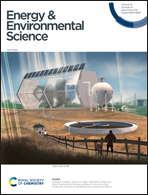Anionic redox induced anomalous structural transition in Ni-rich cathodes†
Abstract
Ni-rich cathodes have emerged as one of the most promising candidates for power next generation electric vehicles. However, they often suffer from poor capacity retention when charged to high voltages and the origin of this degradation remains elusive. Here, by using high throughput operando neutron diffraction, a universal four-stage structural evolution of Ni-rich cathodes is revealed during the initial cycle for the first time. Particularly, we discovered a universal structural transition in Ni-rich cathodes at ∼75% delithiation irrespective of Ni or substituent contents. This transition is hallmarked by the anomalous increase of average TM–O bond lengths, contradicting the conventional wisdom that TM–O bond lengths decrease during charge (oxidation). This anomaly is induced by the direct oxidation of lattice oxygen ions, which is rooted in the drastic decrease of oxygen-to-TM charge transfer gap at high degrees of delithiation. The onset of this anomalous transition matches very well with the onset of oxygen gas release and severe decline of capacity retention in Ni-rich cathodes, suggesting that this bulk structural transition plays an indispensable role in the degradation process. These findings shed light on the elusive degradation mechanism of Ni-rich cathodes, providing valuable clues to stabilize oxidized oxygen ions for stable cycling of layered oxide cathodes at high voltages.



 Please wait while we load your content...
Please wait while we load your content...
